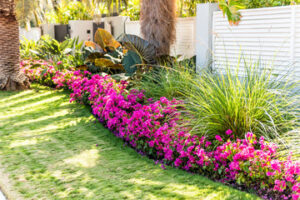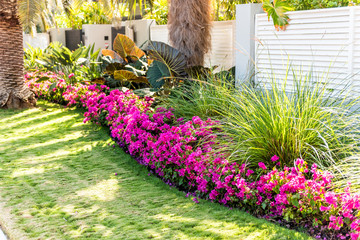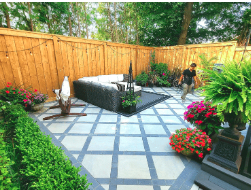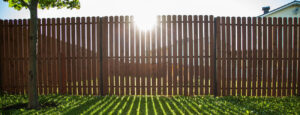Jupiter Landscaping enhances your property’s appearance and raises its value. It also provides benefits such as reducing noise pollution, filtering water runoff and adding natural beauty to the environment.
Proper scale and pacing provide unity to the garden by drawing the eye to specific focal points. These include statues, water features, and other ornaments.
A well-designed landscape not only looks beautiful but also raises property value, makes a home more functional, and is good for the environment. Landscape design involves the arrangement of outdoor elements, such as plants, flowers, trees, mulch, rocks, water features, and ornamental objects like lanterns or pagodas. The designer considers color, shape, and texture to achieve balance and harmony. The designer must also take into account the climate, soil conditions, sun exposure, and maintenance needs of the landscape.
The design process starts with an assessment of the site. This includes noting the location and size of existing features, such as fences or buildings, as well as the topography of the land. The designer also takes into consideration how the landscape will be used and whether there are any environmental issues to address, such as drainage problems or erosion concerns.
After the assessment, the designer creates a plan based on the client’s needs and preferences. This may include an outline of plantings and the placement of existing and new structures. For example, a walkway might be positioned so it follows a slope or to create visual contrast with the surrounding landscape. The designer may also include a water feature, such as a pond, stream, or waterfall, to add interest and provide a focal point. Ornaments like lanterns and pagodas can add a sense of drama to the landscape.
Another aspect of landscape design is the creation of hardscapes, or non-plant elements. These can include walkways, patios, retaining walls, and other outdoor structures. Hardscaping can also serve practical purposes, such as providing privacy and preventing stormwater runoff.
The design of a landscape can vary from a simple lawn to a complex garden with a variety of plants, shrubs, and trees. It can be formal, with trimmed hedges and symmetrical plantings, or more natural with a mix of perennials and annuals. Whatever the style, a quality landscape should be balanced and harmonious, with a connection between house and garden.
Plants
The plants used in a landscape can have a significant impact on the design. They can create boundaries, shade and add visual appeal to the property. Moreover, they can improve soil quality and help with water conservation. There are different types of plants, such as grasses, shrubs and trees. Some can be annuals, meaning they grow only one season, bi-annuals with a two-year lifespan and perennials that come back year after year.
In addition to aesthetics, landscaping can also be a form of healing and therapy for people. Plants and trees can bring joy and increase mental health, as well as reduce stress and anxiety. They can even aid in rehabilitation and recovery from addiction. As a result, many healthcare facilities use landscaping in their buildings. This can include gardens, rooftops and courtyards.
A well-kept landscape can provide a great first impression for your business. It can increase customer traffic and lead to greater profits. Studies have shown that customers and clients spend more at businesses they perceive as attractive, neat and well-maintained.
Landscapers can help businesses and individuals with a wide variety of services, including lawn care, pruning, water management and maintenance. They can also recommend plants and trees that are suited to a particular environment and climate. They can also assist with garden planning and installation.
The landscape industry is a major contributor to local economies. According to Jobber’s Home Service Economic Report, it generates more than $153 billion in revenue annually. It has a strong demand for services, especially for residential properties. Its growth shows that even as consumers tighten their budgets, they still value outdoor maintenance and other lawn-related services.
In the future, landscapers may be able to increase efficiency by using new technology. Juniper Landscaping, for example, uses drones to inspect properties and save labor costs. Electric Sheep is another company that makes robotic conversion kits for legacy gas-powered lawn mowers. Other companies are developing artificial intelligence-powered robots to help with landscaping tasks. As the landscape industry evolves, it will be critical for businesses to adapt to these changes and stay competitive.
Hardscaping
The non-living parts of a landscape are referred to as hardscape. This includes everything from stones and bricks to wood and concrete. Almost any solid construction within the landscape is considered hardscape, including lawns, flower beds, and walkways. Hardscape can also be more complex features, such as retaining walls or patios.
The purpose of hardscaping is to create a design that adds both function and style to outdoor spaces. When used properly, hardscape can make your home more appealing while cutting down on maintenance and boosting resale value. However, it’s important to keep in mind that the style of hardscape should complement the overall design of your yard.
Many people mistakenly think that landscaping and hardscaping are the same things, but there are differences between the two services. Landscaping is more about creating curb appeal and adding beauty to your property while hardscaping involves incorporating elements that have a practical use, such as pathways or decks.
When designing your hardscape, it’s a good idea to consider how people will use the space. For example, if you want to entertain guests, you might want to include seating areas and a fire pit. Hardscape designs can also help with drainage and ensure that your yard doesn’t flood during heavy rains.
Another benefit of hardscaping is that it can improve your home’s energy efficiency. For instance, a backyard fire pit can help reduce the amount of electricity you use to heat your home. Additionally, it can help to reduce the amount of greenhouse gases you produce.
Having the right hardscaping can make your yard more beautiful and functional, but it’s also important to remember that the materials you choose should be durable. A professional landscaper can recommend the best materials for your particular needs and install them correctly to ensure that they last for a long time.
It’s also a good idea to consider the impact that your hardscape will have on your neighborhood. For example, if you have a pool or gazebo in your yard, it can affect the surrounding homes’ values. Additionally, you’ll need to ensure that your hardscape is safe for the community and doesn’t pose a risk of damage to neighboring properties during storms or high winds.
Lighting
Landscape lighting helps your home and landscaping remain useful after the sun goes down. It illuminates pathways for safety and accentuates features such as water fountains or statues to create a stunning focal point. In addition, it can extend the use of outdoor spaces into the night, so you can host evening parties or unwind in a cozy outdoor retreat.
There are many ways to incorporate landscape lighting into your property, including using different light levels to highlight different aspects of your landscaping. The right lighting can create a striking effect, while still being functional and keeping with your home’s aesthetic. When planning your lighting, consider the size of your landscape or structure and how you plan to use it after dark. Depending on these factors, you may need more subtle or less subtle lighting to achieve the desired effect.
The types of fixtures you choose for your lighting will also play a role in how the final result looks. Spot lights, well lights, and low-voltage flood lights are commonly used for uplighting to illuminate plants and trees from below. Grazing lighting is another technique that highlights textured walls by casting shadows on their surface. Lastly, wall washing offers a uniform glow for building facades or long rows of shrubbery.
Another element to keep in mind when designing your landscape is the impact that different color temperatures can have on the ambiance of the space. Warmer colors can evoke a more intimate, romantic feel while cooler tones can provide a more modern or contemporary look.
Ultimately, your goals for landscape lighting should be to improve the usability of your yard after dark and elevate the look of your home’s exterior. Illuminating walkways and reducing the risk of tripping and falling will make it safer for your family and guests to navigate your property at night. Incorporating lighting for safety can also deter trespassers and burglars, which gives you added peace of mind at your home.






